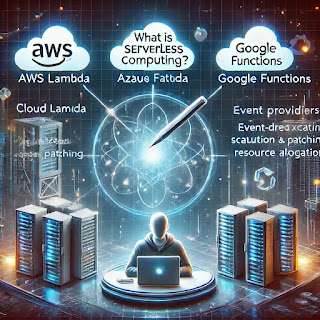Serverless Computing: Benefits, Challenges, and Use Cases.
Imagine running an application
without worrying about servers—no provisioning, no scaling headaches, no
maintenance. That’s the promise of serverless computing, a cloud computing
model that’s transforming how businesses deploy software.
But is serverless all sunshine
and rainbows? Like any technology, it has trade-offs. In this article, we’ll
break down:
·
What serverless computing really means (hint:
there are still servers involved!)
·
The key benefits driving its adoption
·
The challenges you should be aware of
·
Real-world use cases where serverless shines
By the end, you’ll have a clear
understanding of whether serverless is right for your next project.
What is Serverless Computing?
Despite the name, serverless
computing doesn’t mean servers disappear—they’re just abstracted away from
developers. Instead of managing virtual machines or containers, you write code
(usually functions) that run in response to events. The cloud provider (AWS
Lambda, Azure Functions, Google Cloud Functions) handles the rest: scaling,
patching, and resource allocation.
How It Works?
·
Event-Driven
Execution: Your code runs only when triggered (e.g., an HTTP request, file
upload, or database change).
·
Automatic
Scaling: If 10,000 requests hit your function at once, the cloud provider
spins up instances to handle the load.
·
Pay-Per-Use
Billing: You’re charged only for the milliseconds your code executes—not idle
server time.
This model is a game-changer for
certain workloads, but it’s not a one-size-fits-all solution.
Benefits of Serverless Computing
1. Reduced
Operational Overhead
No more server maintenance, OS
updates, or capacity planning. Developers focus on writing code, not managing
infrastructure.
Example: A
startup can deploy a backend API without hiring a DevOps team, accelerating
time-to-market.
2. Cost Efficiency
Traditional cloud servers bill
you 24/7, even when idle. With serverless, you pay only for actual usage.
·
AWS
Lambda costs ~$0.20 per 1 million requests after the free tier.
·
A low-traffic app might cost pennies per month,
whereas a traditional VM could cost $10+ for the same workload.
3. Infinite
Scalability
Serverless functions scale
instantly to handle traffic spikes.
Case Study:
Netflix uses AWS Lambda to process millions of video transcoding jobs daily
without manual scaling.
4. Faster Development
Cycles
Developers deploy small,
independent functions rather than monolithic apps. This enables:
·
Microservices architecture
·
Rapid iterations (updates can be pushed in
minutes)
Challenges of Serverless Computing
While serverless offers
compelling advantages, it’s not without hurdles.
1. Cold Starts
When a function hasn’t been used
recently, the first request may experience latency (sometimes 1-5 seconds) as
the cloud provider initializes resources.
Mitigation:
·
Keep functions warm with periodic pings.
·
Use provisioned concurrency (AWS Lambda
feature).
2. Vendor Lock-In
Each cloud provider has its own
serverless quirks. Migrating from AWS Lambda to Azure Functions isn’t always
seamless.
Workaround: Use
frameworks like Serverless Framework or Knative for portability.
3. Debugging and
Monitoring Complexity
Traditional logging tools don’t
always work well with ephemeral serverless functions.
Solution: Adopt
distributed tracing (e.g., AWS X-Ray, Datadog) for better visibility.
4. Limited Execution
Time
Most providers impose time limits
(e.g., 15 minutes max per execution). Long-running tasks may need alternative
solutions.
Serverless Use Cases: Where It Excels
Serverless isn’t ideal for every scenario, but it’s perfect
for:
1. Event-Driven
Processing
·
File
uploads: Resize images when a user uploads to S3.
·
Real-time
data pipelines: Process IoT sensor data in Azure Functions.
2. APIs and
Microservices
·
Backend
for mobile/web apps: Serverless APIs scale effortlessly.
·
Authentication:
AWS Cognito triggers Lambda for custom auth flows.
3. Scheduled Tasks
(Cron Jobs)
·
Database cleanup
·
Daily report generation
4. Chatbots and Voice
Assistants
·
Alexa Skills and Google Actions often run on
serverless backends.
Conclusion: Is Serverless Right for You?
Serverless computing is
revolutionary for the right workloads—offering cost savings, scalability, and
reduced ops overhead. However, cold starts, debugging complexity, and vendor
lock-in are real concerns.
Consider serverless
if:
✔ Your workload is sporadic or
event-driven.
✔ You want to minimize
infrastructure management.
✔ Cost efficiency and
auto-scaling are priorities.
Avoid serverless if:
❌ You need long-running
processes (e.g., video encoding).
❌ Your app requires low-latency
consistency (cold starts are a dealbreaker).
The future of serverless is
bright, with advancements like serverless containers (AWS Fargate) and edge
computing pushing boundaries. As cloud providers iron out the kinks, expect
even more businesses to go serverless.
So—will your next project be serverless? 🚀





